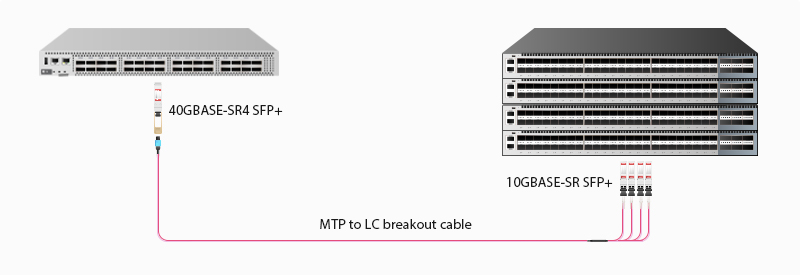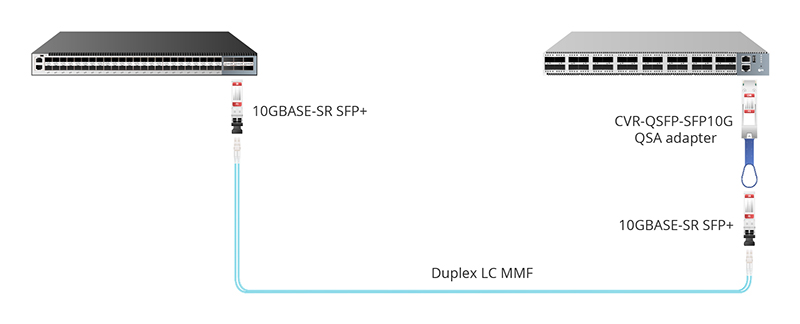

 Knowledge Base +
Knowledge Base +  2024.01.09
2024.01.09QSFP+ (Quad Small Form-Factor Pluggable Plus) and SFP+ (Small Form-Factor Pluggable Plus) are two different form factors for optical transceivers used in high-speed data communication. They are not directly compatible with each other due to differences in their physical design and the number of channels they support. Here are some key differences:
Form Factor:
QSFP+: QSFP+ is a larger form factor that supports up to four channels (usually used for 40G or 100G Ethernet).
SFP+: SFP+ is a smaller form factor designed for one channel (commonly used for 10G Ethernet).
Connector Type:
QSFP+: QSFP+ connectors are larger and have more pins than SFP+ connectors.
SFP+: SFP+ connectors are smaller and have fewer pins compared to QSFP+ connectors.
Number of Channels:
QSFP+: Supports multiple channels, typically four, allowing for higher data transfer rates (e.g., 40G or 100G).
SFP+: Supports a single channel, providing lower data transfer rates (e.g., 10G).
Port Compatibility:
QSFP+: Typically used in network equipment designed for higher data rates, such as 40G and 100G switches and routers.
SFP+: Commonly used in network equipment supporting lower data rates, such as 10G switches and routers.
Due to these differences, a QSFP+ port is not physically compatible with an SFP+ transceiver, and vice versa. However, there are devices known as "breakout cables" or "splitter cables" that can convert a single QSFP+ port into multiple SFP+ ports. These cables have a QSFP+ connector on one end and multiple SFP+ connectors on the other end. This allows for flexibility in connecting devices with different form factors while maintaining compatibility with the respective data rates.
The first method to directly convert QSFP+ to SFP+ port is using the QSFP+ breakout cable. QSFP+ breakout cables now can be found in direct attach cable (DAC) and active optical cable (AOC) types. Mostly, both two types are pre-terminated with a QSFP+ transceiver on one end and four SFP+ transceivers on the other end, which are known as QSFP+ to SFP+ breakout cables. The difference lies in that DAC is designed with copper cables while AOC uses fiber optics.


In addition, there is another type of 40G AOC breakout cable - QSFP+ to 4 duplex LC cable. It has an QSFP+ transceiver pre-terminated on one end but LC duplex connectors at the other end, which requires additional SFP+ transceivers when used.

No matter what type you choose, all these QSFP+ breakout cables can split a 40G connectivity into 4x10G channels, while you connect them with a QSFP+ switch on the one end and several 10G devices (up to four) containing SFP+ ports on the other end.
The second way to convert QSFP+ to SFP+ port is using MTP/MPO to LC breakout cable. This solution is similar to the prior solution but without the transceiver pre-terminated on each end. With an MTP/MPO connector on one side, MPO/MTP 8-fiber assembly is often equipped with four LC duplex connectors on the other side. To realize the conversion from 40G to 10G using MTP/MPO to LC breakout cable, you need to add one QSFP+ transceiver with MTP/MPO interface and four SFP+ modules with duplex LC interfaces. As the figure is shown below, you just need to plug the cables into the matching 10G or 40G transceivers and then insert these transceivers into QSFP+ port or SFP+ ports.

Another way to directly convert QSFP+ to SFP+ port is via the help of a 10G type of the QSA (quad small form-factor pluggable adapter): CVR-QSFP-SFP10G. Built-in a QSFP+ form factor with a cage for SFP+ module at the back, this QSFP+ to SFP+ adapter enables smooth connectivity between devices that use 40G QSFP+ port and 10G SFP+ port. To have a 10G connection, you can insert an SFP+ module into a QSFP+ to SFP+ adapter and then connect this CVR-QSFP-SFP10G adapter to a QSFP+ port. In that connection, the QSFP+ to SFP+ adapter will act as an interface of an SFP+ module.

Subscribe to the newsletter
for all the latest updates.
2-5# Building, Tongfuyu Industrial Zone, Aiqun Road, Shiyan Street, Baoan District, Shenzhen. China
